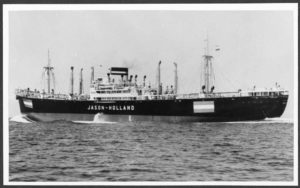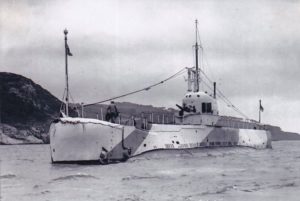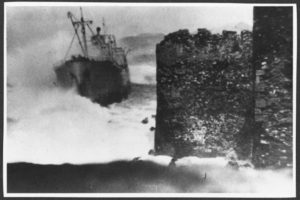- Author
- A.N. Other
- Subjects
- WWII operations, History - WW2
- Tags
-
- RAN Ships
- None noted.
- Publication
- March 2022 edition of the Naval Historical Review (all rights reserved)
By Andreas Biermann1
We were recently contacted by the author regarding an article published in a previous edition of the Naval Historical Review in which we incorrectly attributed the date of the sinking of an Italian ship Sebastiano Veniero. As Andreas obviously knew considerable detail we asked if he would provide us with an article, and this is the story of the ship in which a large number of New Zealand troops tragically lost their lives when she was torpedoed by an Allied submarine.
Introduction
Following the entry of Italy into the Second World War, the Mediterranean became a battlefield in which the Axis and Allied forces struggled for control of vital supply lines. A particular aspect of the campaign was the attack on vessels carrying British and Dominion (B & D) prisoners of war. In late 1941 and early 1942, these attacks cost the lives of well over 1,000 B & D prisoners. This article provides some further detail on the loss of the first of these ships, the Italian MV Sebastiano Veniero2, on 9 December 1941.

By early December 1941 thousands of B & D soldiers had been captured by Axis forces in Operation CRUSADER. They were removed from the forward combat zone around Tobruk to the main supply port of Benghazi, 460 km to the west. The burden they presented on supply requirements in North Africa necessitated their further removal to Europe, exposing them to attack by Allied forces because, unlike hospital ships, prisoner transports were not readily identified. Removals commenced in early December 1941, with the modern MV Sebastiano Veniero being one of the first merchant vessels to carry prisoners north. Most of the prisoners in her were South Africans of the 5th S.A. Infantry Brigade, captured at Sidi Rezegh on 23 November 1941, and New Zealanders, captured outside Tobruk during operations from 29 November to 2 December 1941.
At the end of November, the North African convoy route was in a deep crisis but Veniero, escorted by the elderly Navigatori-class destroyer Ct da Verrazzano, had successfully made the journey from Taranto to Benghazi where they arrived on 1 December 1941, carrying an important cargo including 590 tons of urgently needed ammunition, 190 vehicles and 14 Italian M13/40 medium tanks.
Also on 1 December, a Spica-class torpedo boat Tp Centauro arrived in Benghazi, escorting the German SS Spezia, a smaller merchant vessel plying the coastal convoy route between Tripoli and Benghazi, and the German high seas tug Max Behrendt. The latter had been requested by the Kriegsmarine to help salvage SS Tinos, a German merchantman which had arrived in Benghazi on 22 November; in a RAAF night attack shortly after she had been bombed and sunk in the harbour. Her crew was taken off while attempts are made to refloat her but by early December it was clear that this would take more time and 15 of her German crew were sent to Italy on Veniero. One would play a crucial role in the drama of Veniero’s last voyage.
After discharging her cargo at Benghazi, Veniero left the port for Taranto at 1900 hours on 8 December 1941, escorted only by Tp Centauro, carrying 2,000 Commonwealth prisoners.
Three officer prisoners in Tp Centauro included New Zealander Brigadier James Hargest3, who had been captured outside Bardia on 27 November, when the HQ of his 5th New Zealand Brigade was overrun by the Afrika Korps. The small convoy took the easterly course, hugging the coast of Greece to be outside the range of Malta-based Swordfish torpedo bombers. The sea was described by Hargest as choppy, with Tp Centauro rolling heavily throughout and one of the officer prisoners being extremely seasick.

While Tp Centauro carried standard Italian escort Anti-Submarine Warfare (ASW) equipment, in early 1942 she received superior German ASW sonar and depth-charging equipment. However, in December 1941 she had to rely on Italian listening sets which were not effective in heavy weather and/or at higher speeds. Veniero was thus weakly protected, with only one escort vessel with limited ASW capabilities.
At 1425 on 9 December 1941 the RN submarine HMS Porpoise commanded by LCDR Edward Pizey RN sighted Veniero just off Cape Methoni, outside Navarino harbour on the Greek coast. Brigadier Hargest describes the crew of Tp Centauro as being in a high state of alert prior to the attack but does not note any specific indication that Porpoise might have been detected. At 1435 she attacked Veniero with a spread of four torpedoes. Only one of the torpedoes hit, but the Italian crew rapidly abandoned ship. Tp Centauro engaged Porpoise, attacking with 22 depth charges, but none of them fell near the submarine, which made her escape. Urged on by Brigadier Hargest, the captain of Tp Centauro took her closer to shore to offer assistance to Veniero and encourage her crew to reboard her, but due to the sea state they can do no more and retire to nearby Navarino harbour. The Italian naval command immediately sends out two modern destroyers, Soldati–class Ct Ascari and Carabiniere to assist but given the weather conditions there was little more they could do.


Down by the bow and with her steering wrecked, Veniero remained afloat but was so badly damaged that she was beached stern-first in a desperate action under the control of a German engineering officer, almost certainly from SS Tinos, while remaining guards and German crew members of SS Tinos remove the hatch covers in which the prisoners are confined. Following some skilful manoeuvring, about 2½ hours after the torpedo struck her, Veniero is beached under the walls of Methoni castle.
While some survivors jumped into the sea they were unable to make shore. Ultimately a South African, Lance Corporal Bernard Friedlander4 of the 3rd Transvaal Scottish Regiment, entered the boiling sea with a line attached to his body. It took 90 minutes for the exhausted soldier to reach shore. A rope was then passed between ship and shore and about 1,600 survivors used this to reach safety. Once on land, they were assisted by soldiers of a nearby Italian garrison.
Reports state that 309 of the 2,000 Commonwealth prisoners on board died in the attack, most of them when the torpedo struck the forward hold of Veniero, as well as 11 members of the Italian crew and guards. There are other estimates indicating that up to 500 lost their lives.

Based on available sources it is impossible to arrive at a clear breakdown by nationality of the prisoners carried on Veniero. It is generally estimated that 1,200 of the prisoners were South African, primarily from the 5th SA Infantry Brigade, and another 400 New Zealanders captured at the Zaafran battle outside Tobruk. The remainder are likely to be primarily British captured at various locations. It is possible but unlikely that small numbers of AIF personnel were on board. Even then their number would not have been substantial, since the only Australian Army unit involved in CRUSADER was the 2/13 Battalion, which did not report any prisoners taken during operations. In the past, Flying Officer David Rutter of No 3 Squadron RAAF has been identified as a casualty on Veniero, but it is now clear that he died in an air battle at El Adem on the same day.
The Role of ULTRA
By late 1941, the ability of the British command to read Italian and German naval and air force messages encoded on Enigma machines, known as ULTRA, was well-developed. Messages were read with very short delays and in time to guide operational decisions and messages that prisoners were to be carried on merchant vessels returning to Italy had been deciphered since 5 December. Thanks to ULTRA, the departure time and escort arrangements of Veniero were known in London, well before her actual departure. Furthermore, the fact that Veniero had 2,000 prisoners on board was also known in London since 0540 GMT on 8 December, when a message confirming this was decoded.
Porpoise departed Alexandria for her fourteenth war patrol on 28 November, prior to these messages being deciphered in Bletchley Park. While she would have been in contact with her command authorities, and it is likely that sufficient time passed between the message being deciphered and the attack on Veniero to allow for Porpoise to be instructed not to attack merchants moving north, this would have brought with it the risk that such a message would be intercepted or that in the case of capture it would be revealed. Notifying a submarine on patrol could potentially compromise the security of ULTRA.
Thus, not having been informed of this fact, almost 33 hours after the signal confirming that Veniero was carrying 2,000 prisoners was deciphered in Bletchley Park and over 24 hours after this information had reached the Admiralty and Prime Minister’s office in London, Porpoise fired her spread of torpedoes.
After the loss of Veniero
Two days after forcing her to beach, Porpoise undertook another attempt to destroy Veniero, launching a further two torpedoes at her but both failed to find their target. On 15 December, the submarine HMS Torbay (LCDR Anthony Miers RN) succeeded in torpedoing Veniero, putting her beyond repair. The wreck was broken up in situ in the 1950s.
On 14 February 1942 the small U-class submarine HMS P38 (LEUT Rowland Hemingway RN) attacked a north-bound convoy consisting of Italian SS Ariosto, German SS Atlas, and escorts Ct Premuda and Tp Polluce. Ariosto was hit by two torpedoes, going down in the early hours of 15 February, with 138 Commonwealth prisoners lost. On 27 February 1942 the U-class submarine HMS Upholder (LCDR Malcolm Wanklyn RN) sank SS Tembien. At least 390 out of 468 prisoners on board died, together with 41 Italians and 10 Germans. In total, around 1,000 prisoners taken during CRUSADER were killed in these three attacks, equal to approximately 10% of the number of prisoners taken during Operation CRUSADER.
Notes:
1 Andreas Biermann is a German historian who contributes to a number of international journals. He is fluent in English and Italian and is assisted by his Italian born wife. His own military service was with the Luftwaffe during the Cold War. Andreas, who can be contacted via rommelsriposte@ gmail.com, owns the CRUSADER project blog.
2 This 6310-ton passenger/cargo ship was ordered by Lloyd Triestino from a Fiume yard in 1939 but owing to financial difficulties she was sold to a Dutch subsidiary of the British Blue Funnel Line and named Jason. She began sea trials on 9 May 1940, the next day Germany invaded the Netherlands and the ship was seized and assigned to Italian owners and renamed Sebastiano Veniero.
3 Brigadier James Hargest (1891-1944) is one of New Zealand’s most distinguished military officers serving in WWI and WWII. He led his brigade during Operation CRUSADER when captured by German forces. He was held in an Italian POW camp from which he escaped and made his way to England. In observing the Normandy landings, he was killed by enemy shell fire.
4 A German officer noted Friedlander’s heroism and later his comments were passed to British authorities recommending a bravery award. In 1947 when the King & Queen toured South Africa at a ceremony in Johannesburg King George VI personally decorated Friedlander with the George Medal.
Bibliography
Hammond, R.J. Strangling the Axis. Cambridge University Press (2020) (for general background).
Hargest, James. Farewell Campo 12. Pocket Books (Michael Joseph) (1950) (for a description of the voyage north).
USMM, La Difesa del Trafico con l’Africa Settentrionale, Vol. II (for general background).
https://rommelsriposte.com/2008/07/16/so-how-many-men-were-lost-in-the-battle/ (for an overview of losses in CRUSADER).
http://ww2talk.com/index.php?threads/corporal-edward-lee-gamble-1917-–-2003-third-transvaal-scottish-regiment.88858/ (for a survivor’s account of the sinking of MV Sebastiano Veniero).
http://www.scielo.org.za/scielo.php?script=sci_arttext&pid=S0018-229X2018000100006 (on the context and personal experiences of prisoners on board Veniero).
https://www.aifpow.com/part_6__nominal_roll_and_casualty_list/chapter_3__nominal_rollcasualty_list (for a casualty roll of ANZAC casualties in the war against Germany and Italy).
http://conlapelleappesaaunchiodo.blogspot.com/2015/12/centauro.html (for the history of Tp Centauro).
https://uboat.net/allies/warships/ship/3412.html (for the history of HMS Porpoise).
https://www.odt.co.nz/lifestyle/magazine/inadvertent-victims (for background on New Zealand prisoners).
http://www.nzetc.org/tm/scholarly/tei-WH2Pris-_N78986.html (for background on New Zealand prisoners).
https://www.angelfire.com/art/happiclown/Jan.html (for background on the sinking of MV Sebastiano Veniero).
https://viewer.waireto.victoria.ac.nz/client/viewer/IE698288/rep/REP698688/FL698690/t1/c4?dps_dvs=1611586708042~107 (for background on New Zealand prisoners).
http://www.goonintheblock.com (for a description of the sinking of SS Ariosto).




